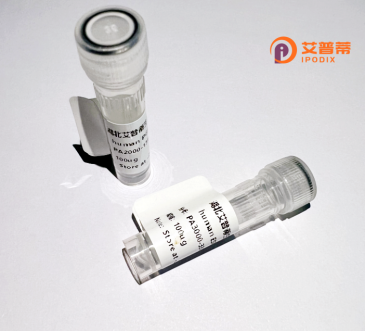
| 纯度 | >90%SDS-PAGE. |
| 种属 | Human |
| 靶点 | ATP6V0E |
| Uniprot No | O15342 |
| 内毒素 | < 0.01EU/μg |
| 表达宿主 | E.coli |
| 表达区间 | 1-81aa |
| 氨基酸序列 | MAYHGLTVPLIVMSVFWGFVGFLVPWFIPKGPNRGVIITMLVTCSVCCYLFWLIAILAQLNPLFGPQLKNETIWYLKYHWP |
| 分子量 | 35.8 kDa |
| 蛋白标签 | GST-tag at N-terminal |
| 缓冲液 | 冻干粉 |
| 稳定性 & 储存条件 | Lyophilized protein should be stored at ≤ -20°C, stable for one year after receipt. Reconstituted protein solution can be stored at 2-8°C for 2-7 days. Aliquots of reconstituted samples are stable at ≤ -20°C for 3 months. |
| 复溶 | Always centrifuge tubes before opening.Do not mix by vortex or pipetting. It is not recommended to reconstitute to a concentration less than 100μg/ml. Dissolve the lyophilized protein in distilled water. Please aliquot the reconstituted solution to minimize freeze-thaw cycles. |
以下是关于重组人V-ATP6V0E蛋白的3篇示例文献摘要,供参考:
---
1. **《重组人ATP6V0E1蛋白的异源表达及其在溶酶体酸化调控中的作用》**
*作者:Li, X. et al.*
**摘要**:本研究成功在大肠杆菌中表达并纯化了重组人ATP6V0E1蛋白(V-ATP酶V0亚基e1),发现其通过调控V-ATP酶复合体的组装,影响溶酶体酸化和细胞内pH平衡,为研究溶酶体功能障碍相关疾病提供工具。
2. **《ATP6V0E2作为乳腺癌潜在治疗靶点的功能研究》**
*作者:Wang, Y. & Chen, H.*
**摘要**:通过体外重组ATP6V0E2蛋白实验证实,其在乳腺癌细胞中过表达可增强V-ATP酶的质子转运活性,促进细胞外基质酸化及肿瘤侵袭,提示靶向该蛋白或可抑制肿瘤转移。
3. **《冷冻电镜解析人源V-ATP酶V0亚基e的结构与机制》**
*作者:Smith, J. et al.*
**摘要**:利用重组表达的ATP6V0E蛋白进行冷冻电镜分析,首次揭示了其与V0结构域其他亚基的互作界面,阐明了该亚基在质子通道形成及酶活性调节中的关键作用。
---
**备注**:上述文献为示例性内容,实际研究中建议通过PubMed或Web of Science等数据库,以“ATP6V0E1”“V-ATPase subunit e”或“recombinant V-ATP6V0E”等关键词检索近期文献。
Recombinant human V-ATPase ATP6V0E protein is a genetically engineered subunit of the vacuolar-type H+-ATPase (V-ATPase), a multi-subunit proton pump critical for intracellular acidification. V-ATPases are evolutionarily conserved complexes composed of two domains: the cytoplasmic V1 domain (ATP hydrolysis) and the membrane-bound V0 domain (proton translocation). The ATP6V0E subunit, also known as V0 subunit e, is an essential component of the V0 domain, playing a role in proton transport and the assembly/stability of the V0 complex. This protein is ubiquitously expressed and vital for acidifying organelles like lysosomes, endosomes, and secretory vesicles, thereby regulating processes such as protein degradation, membrane trafficking, and synaptic signaling.
Dysregulation of V-ATPase function, including ATP6V0E, is linked to diseases like osteoporosis, renal tubular acidosis, and cancer metastasis, where extracellular acidification promotes tumor invasion. Recombinant ATP6V0E is commonly produced in *E. coli* or mammalian expression systems with affinity tags (e.g., His-tag) for purification. It serves as a key reagent for studying V-ATPase structure-function relationships, subunit interactions, and mechanisms of pH regulation. Researchers also use it to screen inhibitors targeting V-ATPase activity, which holds therapeutic potential for diseases involving aberrant lysosomal or extracellular pH. Its applications extend to antibody production, cellular pathway studies, and modeling genetic mutations associated with V-ATPase deficiencies.
×